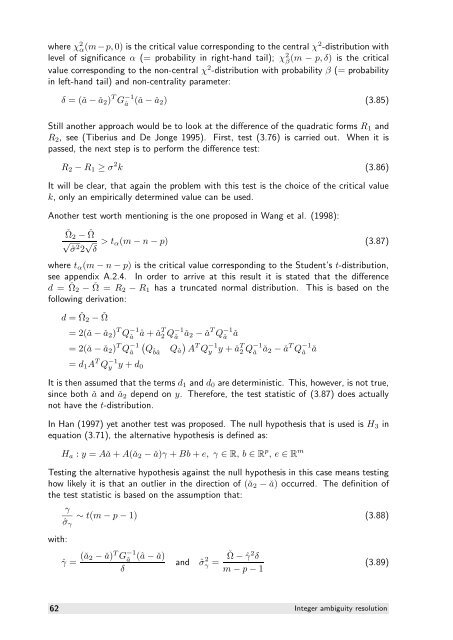The GNSS integer ambiguities: estimation and validation
The GNSS integer ambiguities: estimation and validation
The GNSS integer ambiguities: estimation and validation
You also want an ePaper? Increase the reach of your titles
YUMPU automatically turns print PDFs into web optimized ePapers that Google loves.
where χ2 α(m−p, 0) is the critical value corresponding to the central χ2-distribution with<br />
level of significance α (= probability in right-h<strong>and</strong> tail); χ2 β (m − p, δ) is the critical<br />
value corresponding to the non-central χ2-distribution with probability β (= probability<br />
in left-h<strong>and</strong> tail) <strong>and</strong> non-centrality parameter:<br />
δ = (ǎ − ǎ2) T G −1<br />
â (ǎ − ǎ2) (3.85)<br />
Still another approach would be to look at the difference of the quadratic forms R1 <strong>and</strong><br />
R2, see (Tiberius <strong>and</strong> De Jonge 1995). First, test (3.76) is carried out. When it is<br />
passed, the next step is to perform the difference test:<br />
R2 − R1 ≥ σ 2 k (3.86)<br />
It will be clear, that again the problem with this test is the choice of the critical value<br />
k, only an empirically determined value can be used.<br />
Another test worth mentioning is the one proposed in Wang et al. (1998):<br />
ˇΩ2 − ˇ Ω<br />
√ ˆσ 2 2 √ δ > tα(m − n − p) (3.87)<br />
where tα(m − n − p) is the critical value corresponding to the Student’s t-distribution,<br />
see appendix A.2.4. In order to arrive at this result it is stated that the difference<br />
d = ˇ Ω2 − ˇ Ω = R2 − R1 has a truncated normal distribution. This is based on the<br />
following derivation:<br />
d = ˇ Ω2 − ˇ Ω<br />
= 2(ǎ − ǎ2) T Q −1<br />
â â + ǎT2 Q −1<br />
â ǎ2 − ǎ T Q −1<br />
â ǎ<br />
= 2(ǎ − ǎ2) T Q −1 T −1<br />
â<br />
Qˆbâ Qâ A Qy y + ǎ T 2 Q −1<br />
â ǎ2 − ǎ T Q −1<br />
â ǎ<br />
= d1A T Q −1<br />
y y + d0<br />
It is then assumed that the terms d1 <strong>and</strong> d0 are deterministic. This, however, is not true,<br />
since both ǎ <strong>and</strong> ǎ2 depend on y. <strong>The</strong>refore, the test statistic of (3.87) does actually<br />
not have the t-distribution.<br />
In Han (1997) yet another test was proposed. <strong>The</strong> null hypothesis that is used is H3 in<br />
equation (3.71), the alternative hypothesis is defined as:<br />
Ha : y = Aǎ + A(ǎ2 − ǎ)γ + Bb + e, γ ∈ R, b ∈ R p , e ∈ R m<br />
Testing the alternative hypothesis against the null hypothesis in this case means testing<br />
how likely it is that an outlier in the direction of (ǎ2 − ǎ) occurred. <strong>The</strong> definition of<br />
the test statistic is based on the assumption that:<br />
γ<br />
ˆσγ<br />
with:<br />
∼ t(m − p − 1) (3.88)<br />
ˆγ = (ǎ2 − ǎ) T G −1<br />
â (â − ǎ)<br />
δ<br />
<strong>and</strong> ˆσ 2 γ = ˇ Ω − ˆγ 2 δ<br />
m − p − 1<br />
(3.89)<br />
62 Integer ambiguity resolution
















